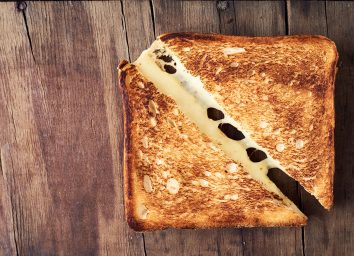
Have you ever flirted with the idea of cooking up a flavor-filled gumbo, a creamy chowder soup, or a luscious homemade pasta sauce? Have you ever wondered what it is that actually makes these dishes so thick and creamy? Well, the thickening agent used to create such a thick and creamy base for either dish is called a roux. (It's pronounced like "roo" like in "kangaroo.")
A what? If this is your first time seeing that word, you're not alone, and we're here to help you understand exactly what it is and how to make it.
First off, what is a roux?
In case you're unfamiliar as to what roux is, it's essentially flour that has been cooked in fat, and it's used to thicken sauces, says Trevor White, Concept Chef at Morton's The Steakhouse in New York City. It has roots in French cuisine, so you also see it often in Creole cooking. We asked the chef to give us insight on the perfect recipe for making this thickening component for some of your favorite sauces and soups right at home. But before we share exactly how to whip up the thickening agent, you should know that there are three different types that are commonly used for different dishes.
What are the different types of roux?
As Chef White explains, there is:
- White roux: "This one is briefly cooked over heat until it develops a frothy appearance."
Use this sauce to: thicken a chowder soup or in a tuna casserole.
- Blond roux: "This one is cooked longer than the white roux and starts to caramelize into a blond color."
Use this sauce to: thicken a bechamel sauce.
- Brown roux: "[This one] is cooked until further caramelized into a brown color, which produces a nutty flavor and aroma."
Use this sauce to: thicken a stock-based soup like gumbo or a dumpling soup.
Now, here's how to make a roux:
Here are steps and tips on Chef White's method you can recreate in your kitchen.
- A roux can have equal parts fat (lard or rendered), clarified butter (without milk solids) or oil, and flour (cake or pastry flour is the best due to high starch content).
- A heavy bottom saucepan or pot is suggested for even cooking and to prevent burning. Slowly heat on the stovetop.
- Add the flour and oil to the saucepot and whisk together. Heat over medium-high heat.
- Cook the roux, stirring constantly until desired doneness.
- A white roux needs only to cook a few minutes until the raw flour taste is gone. Cooking it further, until the flour begins to caramelize, will produce a blond roux. Continuing the cooking process further will produce a brown roux. Remember, the darker you cook it, the more you will need to thicken a liquid.
- One pound of it will thicken approximately one gallon of liquid, and a properly made roux is thick.
- Now, when you're adding the roux to a liquid to make your finalized sauce, temperature plays a vital role in preventing clumps. The rule of thumb is to add the cool or room-temperature liquid to the hot roux while whisking, or add the room-temperature roux to the hot liquid while whisking.
So, let's recap.
First, you want to grab your flour as well as a form of fat, such as lard, butter, or oil, and put the same amount of each into a heavy bottom saucepan and whisk the ingredients together. Stir as your roux cooks over a medium-high heat, and after a few minutes, you'll have a white version. If you cook it for just a few more minutes, you will have the blond variety, and if you cook it even further, you will have a brown version. No matter which type you aspire to cook up, the key is to be sure the sauce is getting thicker as you cook it.








